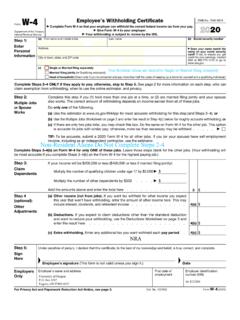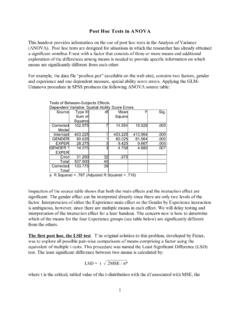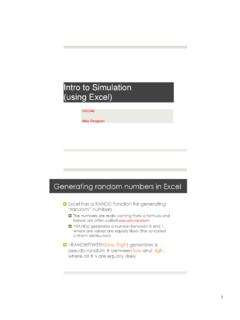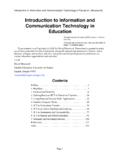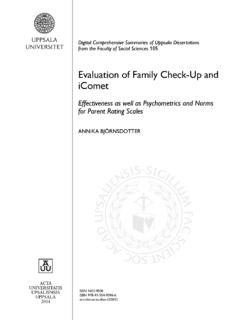Transcription of The Social Costs of Emotional Suppression: A Prospective ...
1 The Social Costs of Emotional suppression : A Prospective Study of theTransition to CollegeSanjay SrivastavaUniversity of OregonMaya TamirBoston CollegeKelly M. McGonigalStanford UniversityOliver P. JohnUniversity of California, BerkeleyJames J. GrossStanford UniversityThere is growing interest in understanding how emotion regulation affects adaptation. The present studyexamined expressive suppression (which involves inhibiting the overt expression of emotion) and howit affects a critical domain of adaptation, Social functioning. This investigation focused on the transitionto college, a time that presents a variety of Emotional and Social challenges. Analyses focused on 2components of suppression : a stable component, representing individual differences expressed bothbefore and after the transition, and a dynamic component, representing variance specific to the newcollege context.
2 Both components of suppression predicted lower Social support, less closeness to others,and lower Social satisfaction. These findings were robustly corroborated across weekly experiencereports, self-reports, and peer reports and are consistent with a theoretical framework that defines emotionregulation as a dynamic process shaped by both stable person factors and environmental :emotion regulation, Social support, Social adjustment, relationship satisfaction, life transitionsThe hundreds of new faces that await freshmen as they begintheir first year of college can be overwhelming. Without thecomforts of home and the familiarity of high school, many studentsexperience a mix of excitement and dread as they prepare to enterthe unknown. During this emotionally intense and disorientingtime, meeting new people, making new friends, and creating a newsocial support system are of paramount importance in having asuccessful first year in college (Christie & Dinham, 1991).
3 Whatfactors influence how students navigate the Social challenges inthis crucial transition?Given the intense emotions that are part of this transition, onecritical factor should be the way individuals regulate their emo-tions. Recent work has shown that one common way that individ-uals regulate emotions is throughexpressive suppression that is,by attempting to inhibit their emotion-expressive behavior. Draw-ing from theory and research on emotions and their Social func-tions, we hypothesized that expressive suppression should havesubstantial and important consequences for Social functioning. Thegoal of the present research is to investigate those Social conse-quences. The focal context of our study, the college transition, isone where we expected those consequences to be particularlypronounced and suppression : A Process Modeland Individual DifferencesAccording to contemporary theories of emotion, emotions beginwith an evaluation of internal or external cues that have particularrelevance to an individual.
4 When attended to and evaluated incertain ways, these emotion cues give rise to a coordinated set ofresponse tendencies that involve experiential, behavioral, andphysiological systems (Mauss, Levenson, McCarter, Wilhelm, &Gross, 2005). The central construct in our investigation, expressivesuppression, may be viewed through the lens of a process model ofemotion regulation (Gross, 2001). Within this model, differentforms of emotion regulation can be distinguished in terms of whenthey have their primary impact along the timeline of the unfoldingemotional response. A broad distinction in the process model isbetween antecedent-focused and response-focused emotion refers to things we do, eitherconsciously or automatically, before emotion-response tendencieshave become fully refers tothings we do once an emotion is underway and response tenden-cies have already been Srivastava, Department of Psychology, University of Oregon;Maya Tamir, Department of Psychology, Boston College; Kelly and James J.
5 Gross, Department of Psychology, StanfordUniversity; Oliver P. John, Department of Psychology, University ofCalifornia, research was supported by National Institutes of Health Grant R01MH58147 to James J. Gross and a Faculty Research Grant from theUniversity of California to Oliver P. concerning this article should be addressed to SanjaySrivastava, Department of Psychology, 1227 University of Oregon, Eu-gene, OR 97403-1227. E-mail: of Personality and Social Psychology 2009 American Psychological Association2009, Vol. 96, No. 4, 883 8970022-3514/09/$ DOI: prominent form of response-focused emotion regulation isexpressive suppression , which may be defined as a form of re-sponse modulation that involves inhibiting ongoing emotion-expressive behavior (Gross, 1998). For example, one might try tolook composed while feeling devastated inside, or one might try tolook calm while feeling angry or resentful.
6 From a theoreticalperspective, several things are noteworthy about , it occurs relatively late in the emotion process, potentiallyafter affective experience has already been generated. Second, ittargets a component of emotion expressive behavior that ispotentially visible to others and that serves a communicativefunction. Thus, the consequences of suppression may extend be-yond internal experience and into the Social studies have demonstrated that people can suc-cessfully use suppression to reduce expressive behavior. In labo-ratory experiments, when participants have been instructed to usesuppression to regulate emotion, they show decreased emotion-expressive behavior ( , Gross & Levenson, 1993, 1997). Inaddition to altering expressive behavior, suppression has somepotential Costs for affective experience.
7 Several studies have foundthat suppression leaves intact the subjective experience of negativeemotion but decreases the experience of positive emotions (Gross& Levenson, 1997; Stepper & Strack, 1993; Strack, Martin, &Stepper, 1988).Research on individual differences in suppression has used theEmotion Regulation questionnaire (ERQ; Gross & John, 2003).This scale includes items referring to suppression of both positiveand negative emotions , as well as general emotion items that donot reference valence; all of the items load on a common, generalfactor. Findings with the scale are consonant with the experimentalresearch and add further information about people who use sup-pression outside of the laboratory. Individuals who make frequentuse of suppression deal with stressful situations by masking theirinner feelings and clamping down on their outward displays ofemotion.
8 Their efforts at suppression leave them with less positiveemotion and with more negative emotions , including feelings ofinauthenticity, than in individuals who use suppression less fre-quently. Such efforts are partially successful, in that individualsexpress less negative emotion than they actually experience; how-ever, in absolute terms, they still express as much as individualswho suppress less frequently. Individual differences in suppressionare distinct from other forms of emotion regulation and are notcorrelated with cognitive reappraisal, an antecedent-focused formof emotion regulation. In terms of the global Big Five traits (John& Srivastava, 1999), suppression is somewhat associated with lowlevels of extraversion but not at all with neuroticism or lowagreeableness (Gross & John, 2003; John & Gross, 2007).
9 The Social Context of Suppression: New Research QuestionsSuppression is a way of regulating emotions that targets expres-sive behavior a component of emotion with a Social -communicative function. An important topic for research, there-fore, is how the use of suppression affects Social functioning. Inone of the few experimental studies of the interpersonal conse-quences of suppression , Butler et al. (2003) had unacquainted pairsof participants watch a documentary about the bombing of Hiro-shima and Nagasaki together and then discuss their reactions. Insome dyads, one partner was instructed (unbeknownst to the other)to suppress their Emotional expressions during the with a partner who suppressed was more stressful thaninteracting with a partner who acted naturally, as indexed byincreases in blood pressure.
10 These findings suggest that by dis-rupting the give and take of Emotional communication, suppres-sion has the potential to undermine Social functioning to a signif-icant studies such as these are an important first step, theyare limited in several ways: They involve an explicit and bluntexperimental manipulation; they feature a single context in whichemotionally expressive behavior was clearly normative and so-cially desirable; and they involve the random assignment of par-ticipants to a suppression group, rather than naturally occurringwithin- or between-person variation in suppression . In the presentstudy, we sought to overcome these and Dynamics in SuppressionMost prior research on emotion regulation has mirrored the twodisciplines of correlational and experimental research identifiedby Cronbach (1957).

